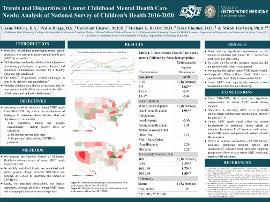| dc.contributor.author | McCoy, Cassie | |
| dc.contributor.author | Braga, Pedro | |
| dc.contributor.author | Elenwo, Covenant | |
| dc.contributor.author | Baxter, Michael | |
| dc.contributor.author | Chesher, Tessa | |
| dc.contributor.author | Hartwell, Micah | |
| dc.date.accessioned | 2023-11-02T20:44:05Z | |
| dc.date.available | 2023-11-02T20:44:05Z | |
| dc.date.issued | 2023-02-17 | |
| dc.identifier | ouhd_BragaMcCoy_trendsanddisparitiesinunmet_2023 | |
| dc.identifier.citation | McCoy, C., Braga, P., Elenwo, C., Baxter, M., Chesher, T., and Hartwell, M. (2023, February 17). Trends and disparities in unmet childhood mental health care needs: Analysis of National Survey of Children's Health 2016-2020. Poster presented at Research Week, Oklahoma State University Center for Health Sciences, Tulsa, Ok. | |
| dc.identifier.uri | https://hdl.handle.net/11244/339870 | |
| dc.description.abstract | Background: With 20% of children experiencing mental health disorders, it is critical to ensure mental health care (MHC) is accessible to all children. The COVID-19 pandemic created unique challenges in MHC delivery and accessibility. Therefore, assessing trends in children’s unmet MHC needs from 2016– 2020 may aid in developing strategies to overcome barriers to MHC. | |
| dc.description.abstract | Objective: Our primary objective is to analyze the trends in unmet needs among the pediatric population from 2016-2020. Our secondary objectives are to identify 1) the disparities among age groups, race/ethnicity, insurance coverage, or urbanicity that exist within the time frame, 2) the changes among each state over this time period, and 3) the potential effects of the COVID-19 pandemic. | |
| dc.description.abstract | Design and Methods: We conducted an observational study of the National Survey of Children’s Health to estimate five-year trends of unmet MHC needs. To identify state-level trends, we calculated each state’s percent change between 2016-2019 and 2019-2020 to determine the impact of COVID-19. Lastly, we measured associations, via logistic regression, between children’s unmet MHC needs and demographic factors to assess disparities. | |
| dc.description.abstract | Results: Between 2016 and 2019, the percentage of children with unmet MHC needs ranged from 17.28% to 22.22%. Nevada had the highest rates of unmet MHC needs at 28.72%, while Montana had the lowest rates of unmet MHC needs at 10.92%. Children between the ages of 3-5 were significantly more likely (AOR: 1.62; CI 1.13-2.33) to have unmet MHC needs than ages 6-10, while adolescents 15-17 were much less likely (AOR: 0.84 95%CI: 0.65-1.08). Compared to White children, Black children were significantly more likely to have unmet MHC (AOR:1.91; CI:1.46-2.50). Unmet MHC was also significantly associated with household income but not urbanicity. | |
| dc.description.abstract | Conclusions: From 2016-2020, there were no significant improvements in unmet MHC needs among children; however, disparities in receiving MHC exist, primarily among Black children and those between the ages of 3-5. Efforts to improve the accessibility of MHC through advocacy, optimized payment options, and expansion of evidence-based programs targeting groups most likely to have unmet MHC needs may improve children’s mental health outcomes. | |
| dc.format | application/pdf | |
| dc.language | en_US | |
| dc.publisher | Oklahoma State University Center for Health Sciences | |
| dc.rights | The author(s) retain the copyright or have the right to deposit the item giving the Oklahoma State University Library a limited, non-exclusive right to share this material in its institutional repository. Contact Digital Resources and Discovery Services at lib-dls@okstate.edu or 405-744-9161 for the permission policy on the use, reproduction or distribution of this material. | |
| dc.title | Trends and disparities in unmet childhood mental health care needs: Analysis of National Survey of Children's Health 2016-2020 | |
| osu.filename | ouhd_BragaMcCoy_trendsanddisparitiesinunmet_2023.pdf | |
| dc.type.genre | Presentation | |
| dc.type.material | Text | |
| dc.subject.keywords | unmet mental health care | |
| dc.subject.keywords | pediatrics | |
| dc.subject.keywords | disparities | |
